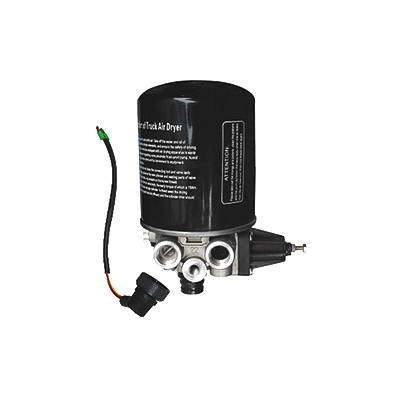The air dryer plays a crucial role in preventing moisture and contaminants in the compressed air system of a truck. Here's how:
Moisture Removal: Moisture ingress is an inherent byproduct of the air compression process within a commercial truck's pneumatic system.
The air dryer assumes a pivotal role in moisture removal, employing a desiccant bed to extract and eliminate water vapor from the compressed air stream.
Effective moisture removal is essential not only for preventing corrosion within the pneumatic components but also for maintaining consistent pneumatic system performance, particularly in adverse weather conditions.
Desiccant Material: Silica gel, a highly efficient and widely utilized desiccant material, is preferred for its hygroscopic properties.
The desiccant bed, often housed in dedicated cartridges, acts as a molecular sieve, attracting and adsorbing moisture molecules from the compressed air flow.
Regular assessment and replacement of the desiccant material are integral to sustaining optimal air drying efficacy.
Contaminant Filtration: Contaminants, ranging from particulate matter to oil aerosols, can compromise the operational integrity of pneumatic components.
The air dryer integrates sophisticated filtration mechanisms, including coalescing filters, to arrest and eliminate contaminants before they traverse downstream.
Robust filtration not only enhances the operational longevity of pneumatic components but also ensures the consistent functionality of ancillary systems, such as ABS (Anti-lock Braking System) and traction control.
Preventing Icing: In frigid environments, the air dryer plays a critical role in averting ice formation within the air brake system.
By regulating the dew point of the compressed air, the air dryer mitigates the risk of ice accumulation in valves and lines, thereby averting potential blockages and system failures.
This anti-icing function is instrumental in sustaining operational reliability, especially in regions characterized by sub-zero temperatures.
Extended Component Life: Moisture and contaminants accelerate wear, corrosion, and degradation of pneumatic components.
The air dryer, by consistently delivering dry and purified air, acts as a proactive safeguard against premature component failure.
Pneumatic valves, brake chambers, and associated elements experience prolonged operational life, contributing to overall fleet reliability and reducing the total cost of ownership.
Enhancing System Efficiency: Brake fade, a phenomenon linked to the presence of moisture in the braking system, poses a significant safety risk.
The air dryer's role in maintaining dry air ensures consistent and reliable braking performance, mitigating the risk of brake fade and promoting vehicle safety.
This enhancement in system efficiency aligns with regulatory safety standards and underscores the air dryer's pivotal contribution to the overall performance of the commercial vehicle.
The multifaceted contributions of the air dryer in moisture removal, contaminant filtration, anti-icing measures, and the extension of component life collectively underscore its indispensable role in upholding the reliability, safety, and operational efficiency of the pneumatic systems in commercial trucks. Regular assessments, adherence to maintenance schedules, and a proactive approach to component replacement are imperative for sustaining the optimal functionality of air dryers in this critical operational context.
AIR DRYER

AIR DRYER




 English
English Español
Español











